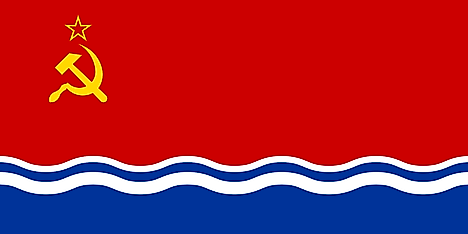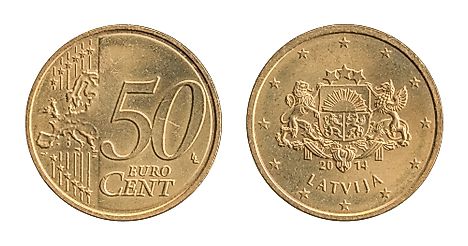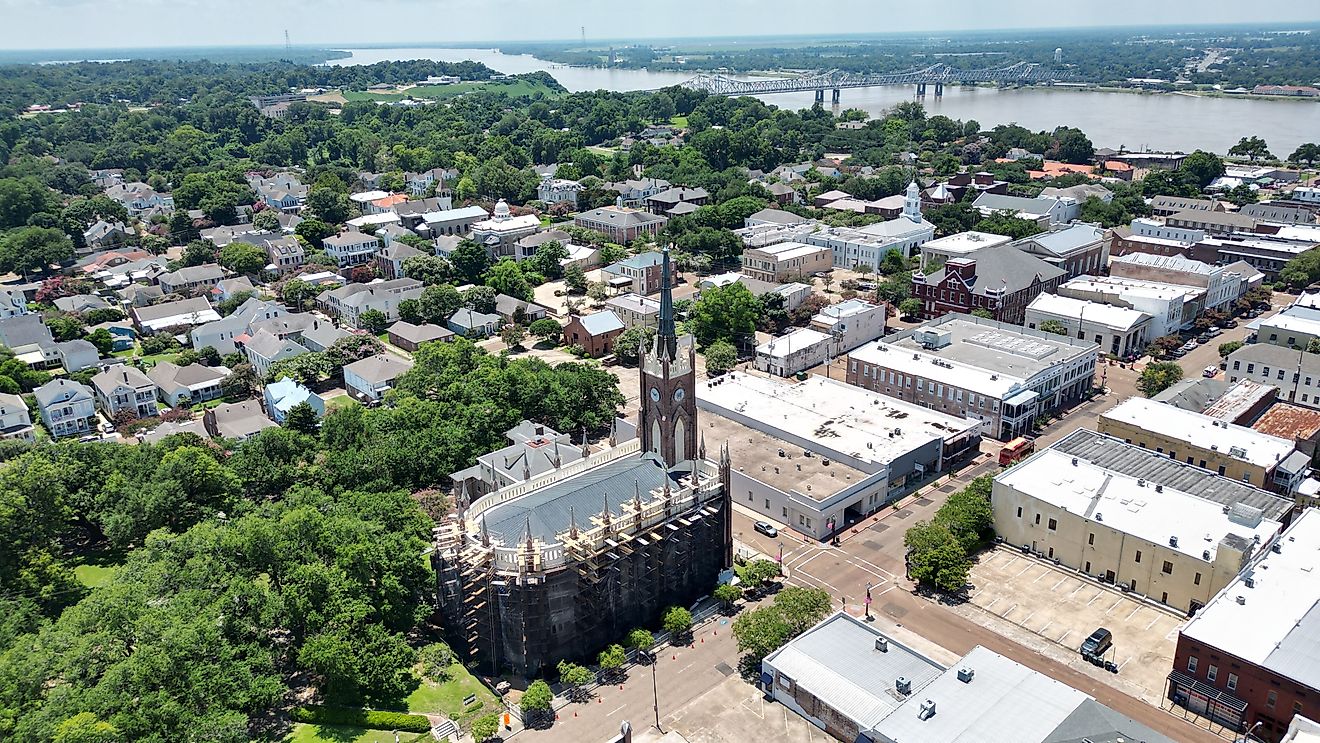Flags, Symbols, & Currencies of Latvia
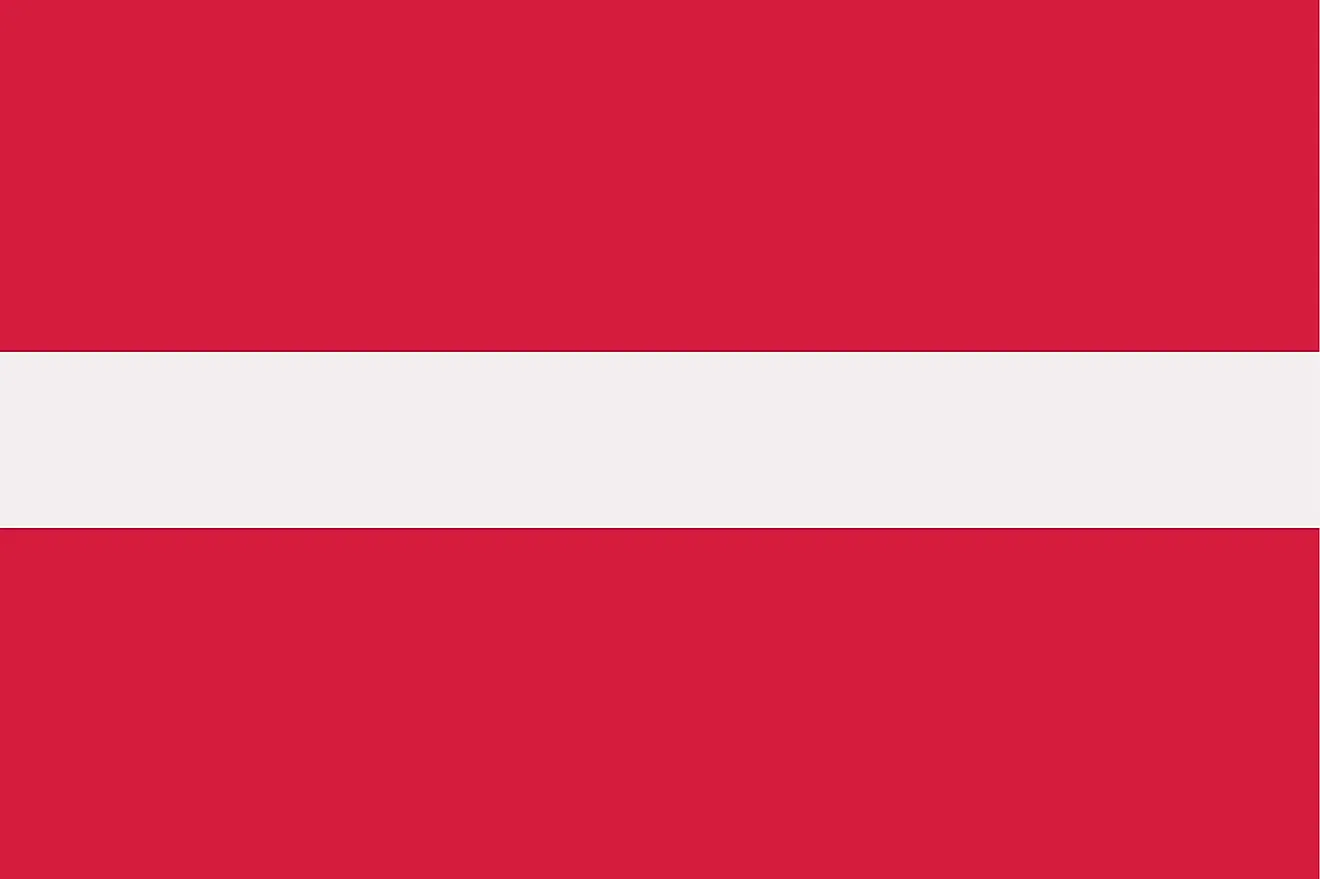
Latvia's flag was officially adopted on November 18, 1918, and restored on February 27, 1990, following the collapse of Latvian SSR.The Latvian flag has a simple design that features a carmine (deep red) colored field that is bisected by a narrow white band. The width of the white band is one-fifth the width of the entire flag.
The red color of Latvia’s national flag is often described as "Latvian red," and is one of the darker shades of red and is composed of purple and brown. It is believed that the red color of the flag symbolizes the will of the Latvians to sacrifice their lives for the country and their readiness to defend the freedom of their country at all costs.
A legend is also associated with the choice of colors for the flag. According to legend, a Latvian leader was wounded while fighting a battle. His body was then wrapped in a white sheet which became stained by his blood. Thus, it is claimed that the red and white of the flag of Latvia symbolizes this legend and the white might represent the sheet that wrapped the wounded leader.
History of the National Flag of Latvia
The current national flag of Latvia was first adopted in 1918 upon the country's independence from Russia after the First World War. However, use of the flag was suppressed during the period of Soviet rule. On February 27, 1990, about two months prior to attaining independence once again, the original flag was re-adopted. Although officially adopted in the 20th century, the flag of Estonia was used as early as the 13th century. In fact, the flag of Latvia is one of the world’s oldest national flags still in use today. A reference to this flag can be found in the Rhymed Chronicle of Livonia.
Symbols of Latvia
National Coat of Arms of Latvia
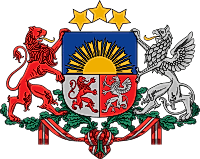
The Latvian coat of arms was officially adopted on August 19, 1921. It was derived from the national symbols and arms of the Swedish and Polish Livonia. Thus, it combines symbols of the statehood and ancient historical districts of Latvia. The coat of arms comprises a shield divided into two halves. The upper half is bue with golden sun, symbolizing national statehood. The sub has 17 rays symbolizing the 17 Latvian-inhabited districts. The lower half of the shield contains red and silver lions, which also support the shield on each side. The red lion represents the Western and southwestern Latvia, while Northeastern and southeastern Latvia are represented by the silver lion.The 3 stars atop the shield represent the historical districts (united Kurzeme – Zemgale, Vidzeme and Latgale). Below the shield are two oak branches tied togather by a ribbon with the Latvian flag colors.
National Anthem
- Anthem Title: Dievs, svētī Latviju! ("God Bless Latvia")
- Music composer and Lyricist: Kārlis Baumanis
- Date of Adoption: 1920 (readopted in 1990)
Dievs, svētī Latviju! ("God Bless Latvia") is the national anthem of Latvia. It consists of two short verses of four lines, with a total of 28 words, making it one of the world's shortest anthems. The lyrics were written and set to music by Kārlis Baumanis in 1873. The song may have been borrowed from a popular song whose melody resembled "God Save the Queen." The song was adopted as Latvian national anthem in 1920. However, during the Soviet era, the anthem was banned and was only restored in February 1990.
Dievs, svētī Latviju!
Dievs, svētī Latviju!
Mūs' dārgo tēviju
Svētī jel Latviju
Ak, svētī jel to!
Kur latvju meitas zied
Kur latvju dēli dzied
Laid mums tur laimē diet
Mūs' Latvijā!
God Bless Latvia!
God, bless Latvia!
Our beloved fatherland,
Bless Latvia,
Oh bless it, yet again! (repeat)
Where Latvian daughters bloom,
Where Latvian sons sing,
Let us dance for joy there,
In our Latvia! (repeat)
The Currency of Latvia is the Euro
In a bid to restore its economic position in the region, the country sought monetary measures through the Central Bank by regulating credit to the private sector and internal devaluation of its currency. The most notable measure was changing the country’s currency in 2014, with the euro replacing the Latvian lat that have been in circulation since 1922.
Latvian Euro
One of the key requirements for any country joining the European Union is to adopt the euro as the official currency. In January 2014, Latvian official currency was changed from lats to the euro. The tender to mint the Latvian euro was given to the Mint of Stuttgart in Germany, who minted the currency in the form of coins with the mint mark "F" and bearing images that symbolize Latvia and its core values. 1 and 2 euro coins bear the symbol of the Latvian maiden denoting both traditional virtue and Latvian national currency. The symbol of the maiden also appeared on the 5 lats coin prior to the World War II.
The 10, 20 and 50-cent euro coins bear the Greater Coat of Arms symbol with the rising sun denoting national sovereignty. It is also a distinctive feature of the soldiers who fought against the Germans during World War I. The Lions and Griffin symbolize the unity of the three Latvian regions, which form the Republic of Latvia. The 2 and 5 cent euro coins bear the symbol of the lesser coat of arms symbolizing the proclamation of an independent republic. The lesser coat of arms denotes national statehood and the ancient historic districts.
Historical Currencies of Latvia
When the Republic of Latvia was formed in 1918, there were different currencies in circulation, such as the ostrubles and ostmarks, which were circulated by the German authorities, Russian Tsar rubles and kopecks, also commonly referred to as "Money of Duma," and promissory notes from other several town municipalities. In 1919, the minister of finance set forth the recognition of three foreign currencies as legal tender, but undertook measures to have Latvia’s own currency. In March 1919, the first Latvian banknotes were introduced in several denominations ranging from 1 to 500 Latvian rublis, and also included the denominations of 5, 10, 25 and 50 paper kopecks, through the help of several Latvian artists including Burkards Dzenis, Hermanis Grīnbergs, and Rihards Zariņš. In October 1922, a Constitutional Assembly policy was passed and declared the lat, abbreviated as Ls, as the official Latvian currency. The Bank of Latvia was given the mandate to mint and distribute banknotes in denominations of 10, 20, 25, 50, 100 and 500 latu. Coins were also distributed in denominations of 1, 2, 5 santīmu made of bronze, 10, 20 and 50 santīmu made of nickel, and those above one latu made from silver.
